Kentucky Pest News Newsletter
HIGHLIGHTS IN THIS ISSUE
Number 980__________April 7, 2003
ANNOUNCEMENTS
CORN
SOYBEAN
WHEAT
FRUIT
LAWN AND TURF
SHADE TREES AND ORNAMENTALS
IPM TRAP COUNTS

ANNOUNCEMENTS
2003 INSECT CONTROL RECOMMENDATIONS AVAILABLE ONLINE
By Lee Townsend
The 2003 Field Crops and Livestock Insecticide
Recommendations are available online. You can select crop or livestock
pests from appropriate menus. You will get graphics,
scouting information, decision guides, and recommended
pesticides.
There are links to publications and fact sheets. Newly
registered products will be placed here as appropriate.
Bookmark it and use it often.
See "Insect Management Recommendations"
for insecticide recommendations on crops and livestock.
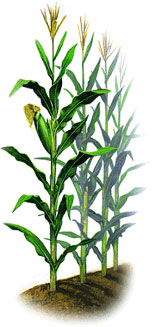
CORN
EARLY-SEASON CORN INJURY DURING COOL WET CONDITIONS
By James R. Martin
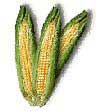 A substantial number of acres have been planted to corn in
portions of western Kentucky where soil conditions have
turned cool and wet. These environmental conditions tend
to slow the metabolism and emergence of corn plants and
allow more exposure time of corn seed and emerging
seedlings to herbicides in soil solution. Prolonged exposure
to certain herbicides can lead to injury.
A substantial number of acres have been planted to corn in
portions of western Kentucky where soil conditions have
turned cool and wet. These environmental conditions tend
to slow the metabolism and emergence of corn plants and
allow more exposure time of corn seed and emerging
seedlings to herbicides in soil solution. Prolonged exposure
to certain herbicides can lead to injury.
The following is a brief discussion of some of the herbicides
and symptoms associated with early-season corn injury
during cool wet soil conditions:
Chloroacetamide / Oxyacetamide Herbicides: Chloroacetamide
herbicides are widely used for weed management in corn.
Examples of herbicides in this class of chemistry are
acetochlor (Degree, Harness, TopNotch, Degree Xtra,
FieldMaster, Ful Time, Harness Xtra, or Keystone,); alachlor
(Micro-Tech, Partner, or Bullet); dimethenamid-P (Outlook
or Guardsman Max); and S-metolachlor (Dual II Magnum,
Cinch, Bicep II Magnum, Cinch Atz, or Lumax). Flufenacet
(Define, Axiom, or Epic) is classified as an oxyacetamide and
is similar to chloroacetamide herbicides.
Although all of these herbicides can injure corn, acetochlor
and S-metolachlor tend to have a greater potential to cause
injury compared with alachlor, dimethenamid-P, or
flufenacet.
All S-metolachlor products with the Roman numeral "II"
included in the trade name and all acetochlor products are
formulated with a safener to limit the risk of corn injury.
Symptoms of corn injury from chloroacetamide and
oxyacetamide herbicides include malformed and stunted
seedlings with twisted leaves that do not unroll properly.
Plants that are severely injured may eventually die because
leaves cannot unroll.
Synthetic-Auxin Herbicides. Products containing 2,4-D and
dicamba (Banvel, Clarity, Oracle, or Sterling) are often
referred to as synthetic-auxin or growth-regulator
herbicides. They can be used to as a part of a burndown
weed control program in no-tillage corn. Their activity is
based primarily on foliar uptake in emerged weeds;
however, they have limited soil-residual activity that can
sometimes result in corn injury.
Corn injury from synthetic-auxin herbicides occurs during
seed germination and resembles symptoms associated with
chloroacetamide and oxyacetamide herbicides. Synthetic-
auxin herbicides often cause abnormalities of both shoots
and roots of corn plants; whereas, chloroacetamide and
oxyacetamide herbicides tend to affect only the shoot
growth.
Products containing 2,4-D generally should not be used
during the period from 7 to 14 days prior to planting until
3 to 5 days after planting and before corn emerges.
Products containing dicamba may injure corn if seed is
planted less than 1.5 inches below the surface.
Isoxaflutole: Injury from products containing isoxaflutole
(Balance Pro or Epic) is seldom an issue in Kentucky but
has occurred when soil conditions were cold and wet and
weather was cloudy for several days following planting.
Corn injury symptoms associated with isoxaflutole range
from minor yellowing or complete bleaching of plants to
significant stand loss. Isoxaflutole does not directly affect
roots but may indirectly limit root growth by inhibiting
photosynthetic activity of plants. Injury from isoxaflutole is
usually short lived but can cause yield loss if corn stands are
reduced.
Pendimethalin: Preemergence applications of pendimethalin
(Prowl) can result in significant injury where corn seed are
exposed to the herbicide. This typically occurs when corn is
planted shallow (less than 1.5 inches deep) or when the seed
furrow is not completely closed or sealed. Injured corn
plants have stunted roots with swollen tips. Corn stands can
be reduced in severe cases. Surviving plants are usually
stunted and may turn purple, particularly during prolonged
cool soil conditions after plant emergence.
Flumetsulam: Extended cold wet conditions (soil temperature
below 50 0 F and excessive rainfall with wet soil conditions)
increases the chance of injury from flumetsulam (Python)
during germination and early development of corn. Injury
symptoms caused by flumetsulam are similar to those
caused by other ALS-inhibiting herbicides and include
yellowing of leaves and /or stunted shoots and a reduced
root system.
For more information about corn pests, visit
"Insect Management Recommendations".

SOYBEAN
EARLY PREPLANT APPLICATIONS OF 2,4-D IN NO-TILL SOYBEANS
By James R. Martin
 The increasing presence of certain broadleaf weeds has
rekindled the interest in using 2,4-D in early preplant
burndonwn treatments in soybeans. This herbicide is
relative inexpensive and enhances the control of marestail,
prickly lettuce, and dandelion when used in approved
burndown combinations.
The increasing presence of certain broadleaf weeds has
rekindled the interest in using 2,4-D in early preplant
burndonwn treatments in soybeans. This herbicide is
relative inexpensive and enhances the control of marestail,
prickly lettuce, and dandelion when used in approved
burndown combinations.
Burndown applications of 2,4-D control weeds primarily
through foliar uptake in emerged plants, however, it has
limited soil-residual activity that can injure soybeans. Early-
season soybean injury from 2,4-D occurs as swollen stems
and roots. Leaves tend to be malformed and elongated and
in severe cases plants will die.
In order to limit the risk of crop injury from 2,4-D, consult
the product label for specific recommendations and
precautions. Be aware that some 2,4-D products are not
labeled for preplant applications in soybeans. As a general
rule, ester formulations of 2,4-D are preferred because of the
less restrictive waiting periods relative to those associated
with amine formulations.
The importance of waiting after application is to allow time
for the herbicide to dissipate before planting soybeans. The
length of waiting period will depend on a number factors
including rate and formulation of herbicide.
When applying ester formulations of 2,4-D, delay planting
soybeans 7 days for rates up to 0.5 lb ae/A and 30 days for
rates greater than 0.5 lb ae/A up to 1 lb ae/A. Consult the
product label for specific rates and restrictions. The
following table shows a few examples of different products
and waiting period for planting no-till soybeans.
| PRODUCT |
WAITING PERIOD |
|
| Salvo (5 lb ae/gal) |
7 Days (Product rate /A): 12.8 oz/A
30 Days (Product rate /A): 25.6 oz/A |
| Weedone LV 4 EC (3.84 lb ae/gal) |
7 Days (Product rate /A): 1 pt/A
30 Days (Product rate /A): 2 pt/A |
| Weedone LV6 (5.4 lb ae/gal) |
7 Days (Product rate /A): 0.67 pt/A
30 Days (Product rate /A): 1.33 pt/A |
| Weedone 638 (2.8 lb ae/gal) |
7 Days (Product rate /A): 1.33 pt/A
30 Days (Product rate /A): 2.67 pt/A |
There is always a risk of crop injury, consequently, growers
who are not willing to accept this risk of injury are advised
to not use 2,4-D in early preplant applications.
For more information about soybean pests, visit
"Insect Management Recommendations".
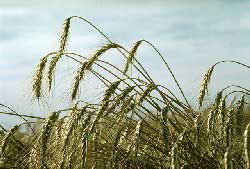
WHEAT
WATCHING ARMYWORM FLIGHT
By Doug Johnson

A number of individuals have asked about (True) armyworm
populations for this spring. It appears that memory of our
outbreak of two years ago lingers.
Armyworm moth flight has begun for the year. If you
check your Kentucky Pest News you will note that a small
number of moths were caught near the third week of
March. Trap catch appears to be on the rise this week. How
does this compare to the normal?
Visit the IPM website at:
http://www.uky.edu/Agriculture/IPM/ipm.htm and
select "Pheromone Traps" from the left side navigation bar,
this will take you to our historic insect flight data. Select
"True Armyworm" from the insects listed. On these pages
you will find flight data for several years as obtained from
pheromone-baited traps. On the bottom of the "True
Armyworm" page you will see a graphic representation of
the average capture for the last five years. This is the
average of two traps for each date. Both of these traps are
on the UK - College of Ag. farm in Princeton, KY. Note that
we are in the 14th week of the year.
The trap counts recorded today on the UK-REC were 1 and
60 for an average of 31. If you look at the Five year average
counts you will see that it is about 100. If you check the
data for 2001 (the outbreak year) you will find that the peak
catch came on what is roughly equlivient to next Friday
(04/11/04) with a counts of 398 & 28 for an average of 213.
It appears we are below both of those marks.
However, the story is not completely told yet. During the
out break of 2001 on the peak moth capture date of April
13th, 302 Day Degrees had accumulated. As of this writing
259 Day Degrees have accumulated. The predicted
accumulation for next week is for a total of 312 by Friday
4/11/04. This indicates that Friday April 11th 2003, will
represent about the same calender date and Degree Day
accumulation as the peak capture date of the 2001 outbreak.
So we need to keep a careful watch on the moth flights for
the next two weeks to see if they increase to the levels of
2001. Moth capture is not a guaranteed indicator of pest
outbreak but is certainly worth watching.
IF we see significant increase in moth capture you should
certainly start checking for armyworms in your small grains
and pastures (though you should do this anyway!!).
Normally, we expect peak armyworm feeding to be about
four weeks after peak moth flight. If moth capture takes a
big up-turn start watching for the worms about two weeks
after peak moth flight. You'll want to discover them well
before peak feeding.
Remember armyworm populations (and all insects) are not
governed by calender date but by temperature. So it is the
Day Degree accumulation that is most important. To see a
write up on this go to KPN #918, May 29, 2001. We would
expect peak worm feeding about 239 DD after peak moth
flight. But, once again that is too late. You need to be
checking your fields well before this event.
See "Insect Management Recommendations" for more wheat pest information.
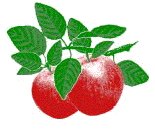
FRUIT
APPLE SCAB AND PEAR FIRE BLIGHT ALERTS
By John Hartman
 Kentucky apple growers will need to be aware that on April
6 and 7, just before bloom for most apples, rainfall was
prolonged enough for moderate to severe apple scab
infection to occur. Eradicant and protectant fungicides, if
used in a timely way, can be used to prevent symptoms
from developing from these infections and to protect apples
from new infections. With trees in full bloom at the start of
the recent rain, pears in many orchards were exposed to fire
blight primary (blossom) infections. Flowering crabapples
and flowering pears were also in bloom and could develop
fire blight from last week's infection event.
Kentucky apple growers will need to be aware that on April
6 and 7, just before bloom for most apples, rainfall was
prolonged enough for moderate to severe apple scab
infection to occur. Eradicant and protectant fungicides, if
used in a timely way, can be used to prevent symptoms
from developing from these infections and to protect apples
from new infections. With trees in full bloom at the start of
the recent rain, pears in many orchards were exposed to fire
blight primary (blossom) infections. Flowering crabapples
and flowering pears were also in bloom and could develop
fire blight from last week's infection event.
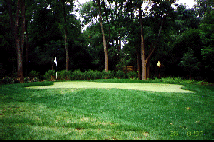
LAWN & TURF
TICKS ARE OUT
By Mike Potter
Few outdoor encounters are as disconcerting as finding an
attached tick. Besides their repulsive appearance, ticks
inflict bites that cause itching and irritation. A small
percentage may also transmit diseases affecting people, pets
and farm animals. This column will help you answer some
of the more common questions about ticks and the diseases
they may transmit.
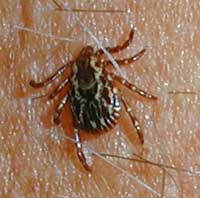 Q: Where do ticks come from and how can I avoid them?
Q: Where do ticks come from and how can I avoid them?
A: Ticks thrive in woods, uncut fields and brush. They
climb onto lower portions of vegetation and attach to a
suitable host passing by. To reduce tick encounters, follow
these precautions:
- Don't walk through uncut fields, brush, and overgrown
areas, especially during April-July. Walk in the center of
mowed trails to avoid brushing up against vegetation.
When hiking or camping in tick-infested areas, wear light-
colored clothing and long pants tucked into boots or socks,
and consider using tick repellent.
- Inspect family and pets after being in tick-prone areas.
Ticks often attach at the waist, armpit, neck and scalp, but
can attach virtually anywhere. Promptly remove any ticks,
using the method discussed below.
- Keep grass and shrubs trimmed, and clear overgrown
vegetation from edges of your property. Ticks and their
wild hosts will not normally infest areas that are well main-
tained. Treating the lawn with insecticides is of little
benefit since mowed areas are not normally infested. If
insecticides are used, treatment should be concentrated
mainly along borders and fences, and between overgrown
areas and the lawn. A good way to confirm if ticks are
present is to drag a white flannel cloth or sheet through
suspected areas. Ticks will attach and be visible against the
white background.
Insecticide sprays containing pyrethroids (e.g., Bayer
Advanced Home/Garden Multi-Insect Killer, Spectracide
Triazicide , Ortho Home Defense System ) or carbaryl
(Sevin) are effective. Such products are sold at
hardware/lawn and garden shops. For better wetting and
coverage of vegetation, it's often best to purchase these
products as concentrates, so that they can be diluted and
applied with a pump up sprayer, hose end sprayer, etc. A
single application during late-April/May, or when ticks are
detected, is often all that's required.
- Free-roaming pets are more likely to become infested
than if confined. Ticks on pets can be controlled or
prevented using sprays, spot-ons, and insecticide-
impregnated collars. See your veterinarian for appropriate
products.
Q: What's the best way to remove an attached tick?
A: Using a tweezers, grasp the tick as close to the skin as
possible and pull it straight out with gentle even pressure.
Petroleum jelly, hot matches and other "folk" methods of
removal should be avoided. Wash the bite area, apply
antiseptic and cover with a band-aid. Attached ticks should
be removed promptly to reduce the chance of infection and
disease transmission.
Q: Some clients use the terms "deer tick" or "turkey
mite" ... what are they referring to?
A: These terms are often used when referring to immature
(larval) lone star ticks, a common tick throughout much of
Kentucky. A person who walks through infested vegetation
may find hundreds of the tiny ticks (about the size of the
period at the end of this sentence) crawling on them.
Unattached larvae can be removed by bathing or showering.
However, once ticks are attached, removal is difficult, and
their bite can be very irritating. The lone star tick is not
considered to be a vector of Lyme disease, although it can
transmit Rocky Mountain spotted fever.
Q: Should I be concerned about getting Lyme Disease or
Rocky Mountain Spotted Fever?
A: Each year about 20 to 40 cases of Lyme disease/Rocky
Mountain spotted fever are reported statewide. Some of
these victims may have been infected while traveling out-of-
state. In Kentucky, probably tens of thousands of people are
bitten by ticks each year; so the likelihood of contracting a
disease is very low. In most cases, a tick must be attached
for at least 18 to 24 hours for infection to occur. One cannot
become infected simply by having a tick crawl over the skin
or clothing. Concerned callers should be informed of the
early symptoms of tick-borne disease, so they will know
whether to seek medical attention.
Q: What are the symptoms of Lyme disease?
A: Lyme disease is difficult to diagnose clinically because
early symptoms mimic the flu, e.g., fatigue, headache, fever,
or swollen glands, pain or stiffness in the neck, muscles or
joints. The most definitive early symptom is a gradually
expanding, circular or oval-shaped red rash, often (but not
always) at the site of the bite. This rash only develops in
about 70% of infected individuals, however, and may be
overlooked. Persons who experience any of the above
symptoms after being bitten by a tick, or after spending time
in an area where ticks are abundant, should see a physician
immediately. In the earliest stages, Lyme disease can be
successfully treated with antibiotics.
The mechanism by which Lyme disease is transmitted in
Kentucky is unclear. The primary tick vector, Ixodes
scapularis, has rarely been found here, although several of
the ticks were found last November while surveying deer
herds in southeastern (McCreary Co.) Kentucky. It's likely
that more will be found in the future.
Q: What are the symptoms of Rocky Mountain spotted
fever?
A: Symptoms of RMSF are flu-like, accompanied by
headaches and a very high fever (104-106 degrees F), two to
12 days after being bitten by a tick. The most characteristic
sign of RMSF is a rash that appears on about the second to
fifth day on wrists and ankles, later spreading to other parts
of the body. When promptly diagnosed, RMSF can be
successfully treated with antibiotics. In the absence of
treatment, victims may die.
Q: I don't have a rash but still feel "crummy" are there
other tick-borne diseases I should be concerned about?
A: Tick bites can result in diseases other than Lyme disease
and Rocky Mountain spotted fever. Human ehrlichiosis is one
important, emerging disease complex, believed to be
transmitted by the species of ticks (e.g., lone star tick)
common in Kentucky. Symptoms of ehrlichiosis in humans
include fever, headache, chills, muscle aches, nausea, and
vomiting. There is usually no rash. Early treatment with
antibiotics is generally prescribed. It's rather common to
experience localized itching and irritation at the site of a
tick bite. But when in doubt, it probably pays to see a
physician.
(For more information on this topic, see ENT-35, Ticks &
Disease In Kentucky)
Q: How important is Rocky Mountain spotted fever?
A: Rocky Mountain spotted fever (RMSF) has not received
the media attention of Lyme disease, but it is potentially
more serious. Each year there are about 10 to 30 cases
reported statewide. The primary vector of RMSF is the
American dog tick, although lone star ticks can also
transmit the disease pathogen.
Symptoms of RMSF are flu-like, accompanied by headaches
and a very high fever (104-106 degrees F), two to 12 days
after being bitten by a tick. The most characteristic sign of
RMSF is a rash that appears on about the second to fifth
day on wrists and ankles, later spreading to other parts of
the body. When promptly diagnosed, RMSF can be
successfully treated with antibiotics. In the absence of
treatment, victims may die. In most cases, the tick must be
attached for at least a day for infection to occur.
SHADE TREES AND ORNAMENTALS
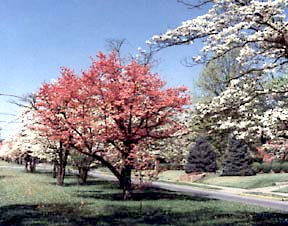
POWDERY MILDEW RESISTANT PHLOX
By John Hartman
 Phlox (Phlox paniculata, Phlox spp.) is a favorite perennial
for Kentucky gardens, but is often disappointing to grow
because of devastation caused by powdery mildew disease.
Powdery mildew, caused by the fungus Erysiphe
cichoracearum, covers the leaves with white fungal growth
late in the season and weakens affected plants. Under our
warm, humid growing conditions in Kentucky, powdery
mildew can be quite severe on susceptible Phlox. Kentucky
gardeners will want to plant powdery mildew resistant
cultivars.
Phlox (Phlox paniculata, Phlox spp.) is a favorite perennial
for Kentucky gardens, but is often disappointing to grow
because of devastation caused by powdery mildew disease.
Powdery mildew, caused by the fungus Erysiphe
cichoracearum, covers the leaves with white fungal growth
late in the season and weakens affected plants. Under our
warm, humid growing conditions in Kentucky, powdery
mildew can be quite severe on susceptible Phlox. Kentucky
gardeners will want to plant powdery mildew resistant
cultivars.
There are some powdery mildew resistant Phlox cultivars
available in the trade. Phlox disease evaluations were
made recently in Arkansas (E. Taylor, et. al.) and North
Carolina (R. Bir, et. al.) and published in the 2002
proceedings of the Southern Nursery Association Research
Conference. The following cultivars were evaluated for
powdery mildew resistance in one or both of these tests.
Cultivars designated with an asterisk (*) were included in
both tests. Highly resistant cultivars are not immune to
powdery mildew, so expect to see a little disease should
those be chosen for the garden. Susceptible cultivars would
need to be sprayed regularly with fungicides to keep them
looking good.
Highly resistant. 'Blue Boy', 'Darwin's Joyce', 'David'*,
'Delta Snow'*, 'Eden's Crush', 'Natascha', Phlox caroliniana,
'Red Magic', 'Robert Poore'*, and 'Speed Limit 45'.
Moderately resistant - moderately susceptible. 'Bright Eyes',
'Eva Cullum', 'Fairest One'*, 'Flamingo', 'Laura',
'Magnificence', 'Miss Ellie', 'Miss Jo-Ellen', 'Miss Katherine',
'Miss Kelly', 'Nicky', 'Nora Leigh', 'Orange Perfection', 'Pink
Gown', 'Prime minister', 'Red Super', 'Rosalinde'*, 'Snow
White', 'Starlight'.
Susceptible. 'Andre', 'Franz Schubert', 'Little Boy', 'Little
Princess', 'Miss Jill', 'Miss Karen', 'Miss Margie', 'Miss
Mary', 'Miss Pepper', 'Miss Universe', 'Mt. Fujiyama',
'Nikki', 'Russian Violet', 'Sir John Falstaff', 'Starfire'*,
'Tenor', 'The King', 'White Admiral'.
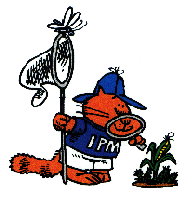
IPM TRAP COUNTS:
By Patty Lucas, University of Kentucky Research Center
Insect Trap Counts
UKREC-Princeton, KY, March 28 - April 4
| Black cutworm
| 1
|
| True armyworm
| 31
|
|
NOTE: Trade names are used to simplify the information presented in
this newsletter. No endorsement by the Cooperative Extension Service
is intended, nor is criticism implied of similar products that are not
named.
Lee Townsend
Extension Entomologist
BACK
TO KY PEST NEWS HOME
 A substantial number of acres have been planted to corn in
portions of western Kentucky where soil conditions have
turned cool and wet. These environmental conditions tend
to slow the metabolism and emergence of corn plants and
allow more exposure time of corn seed and emerging
seedlings to herbicides in soil solution. Prolonged exposure
to certain herbicides can lead to injury.
A substantial number of acres have been planted to corn in
portions of western Kentucky where soil conditions have
turned cool and wet. These environmental conditions tend
to slow the metabolism and emergence of corn plants and
allow more exposure time of corn seed and emerging
seedlings to herbicides in soil solution. Prolonged exposure
to certain herbicides can lead to injury.






 Kentucky apple growers will need to be aware that on April
6 and 7, just before bloom for most apples, rainfall was
prolonged enough for moderate to severe apple scab
infection to occur. Eradicant and protectant fungicides, if
used in a timely way, can be used to prevent symptoms
from developing from these infections and to protect apples
from new infections. With trees in full bloom at the start of
the recent rain, pears in many orchards were exposed to fire
blight primary (blossom) infections. Flowering crabapples
and flowering pears were also in bloom and could develop
fire blight from last week's infection event.
Kentucky apple growers will need to be aware that on April
6 and 7, just before bloom for most apples, rainfall was
prolonged enough for moderate to severe apple scab
infection to occur. Eradicant and protectant fungicides, if
used in a timely way, can be used to prevent symptoms
from developing from these infections and to protect apples
from new infections. With trees in full bloom at the start of
the recent rain, pears in many orchards were exposed to fire
blight primary (blossom) infections. Flowering crabapples
and flowering pears were also in bloom and could develop
fire blight from last week's infection event.

 Q: Where do ticks come from and how can I avoid them?
Q: Where do ticks come from and how can I avoid them?
 Phlox (Phlox paniculata, Phlox spp.) is a favorite perennial
for Kentucky gardens, but is often disappointing to grow
because of devastation caused by powdery mildew disease.
Powdery mildew, caused by the fungus Erysiphe
cichoracearum, covers the leaves with white fungal growth
late in the season and weakens affected plants. Under our
warm, humid growing conditions in Kentucky, powdery
mildew can be quite severe on susceptible Phlox. Kentucky
gardeners will want to plant powdery mildew resistant
cultivars.
Phlox (Phlox paniculata, Phlox spp.) is a favorite perennial
for Kentucky gardens, but is often disappointing to grow
because of devastation caused by powdery mildew disease.
Powdery mildew, caused by the fungus Erysiphe
cichoracearum, covers the leaves with white fungal growth
late in the season and weakens affected plants. Under our
warm, humid growing conditions in Kentucky, powdery
mildew can be quite severe on susceptible Phlox. Kentucky
gardeners will want to plant powdery mildew resistant
cultivars.
